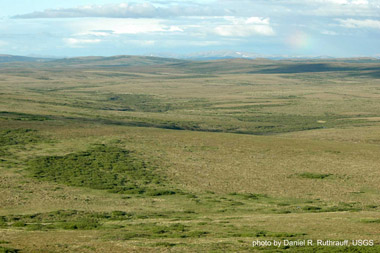Click on image for full size
Image courtesy of Emily Stone, National Science Foundation
Life in the Polar Regions: Animals, Plants, and Others in Extreme Environments
All sorts of living things call Earth’s polar regions home – from tiny lichens encrusting the rocky landscapes of the Arctic tundra to huge blue whales swimming through the frigid waters of the Southern Ocean. Some animals are only part-time residents, migrating to warmer, lower latitudes during the winter months. Others live in polar locales year-round. Most have special adaptations that allow them to survive the extreme cold of the Earth’s polar regions.
The windswept treeless plains of the Arctic tundra sometimes look barren, but they are inhabited by a multitude of plants and animals. A large amount of the land in the north polar region is part of Earth’s tundra biome including the northern parts of Canada, Alaska (U.S.), Scandinavian countries, and Russia, as well as the northern fringes of Greenland that are not covered by ice. Travel south from the Arctic tundra, where temperatures are somewhat less frigid (although still really cold), and you are likely to find vast forests of conifer trees in the taiga biome. Travel north of the Arctic tundra you will find polar bears and the unique marine life in the Arctic Ocean.
In the south polar region, you would find that most of the land, the continent of Antarctica, is covered with a thick layer of ice. You would probably have trouble finding any living things in these ice-covered areas. As a whole, Antarctica has the lowest species diversity of any place on Earth. However, living things inhabit a few areas of the continent. The Antarctic Peninsula, which stretches further north than any other part of the continent, has a diversity of tundra-type species. This Antarctic tundra, like the Arctic tundra, contains no trees or shrubs. Unlike the tundra of the Arctic, there are no naturally occurring land mammals in the Antarctic.
Most food chains on Earth begin with plants or some other organism that gets their energy from the sun through the process of photosynthesis. Animals called herbivores eat the plants, and then other animals eat the herbivores to make the food chain. Because there is virtually no soil in Antarctica, very few plants can survive there. Yet animals do live in Antarctica including many different species of penguin. So how do they get the food they need? The Antarctic food chains are closely tied to the ocean. Almost all animals in Antarctica find their food in the Southern Ocean that surrounds the continent. Marine life in the Southern Ocean is abundant.














